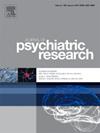Persistent differences in autistic symptom severity after one year in individuals at clinical high risk of psychosis and with first-episode psychosis
IF 3.7
2区 医学
Q1 PSYCHIATRY
引用次数: 0
Abstract
Background
Autistic symptoms have been shown to influence functional outcomes and prognosis not only in schizophrenia but also in individuals at clinical high-risk of psychosis (CHR-P) and those experiencing their first-episode psychosis (FEP). However, it remains unclear whether these symptoms reflect enduring traits that persist over time or whether they are states that can improve with treatment in CHR-P and FEP. This study aimed to investigate the one-year trajectory of autistic symptoms in individuals at CHR-P and with FEP.
Methods
A total of 59 participants who completed a one-year follow-up [CHR-P, n = 34; FEP, n = 25] were categorized into high and low autistic symptom groups based on baseline symptom severity, as assessed by the Positive and Negative Syndrome Scale Autism Severity Score. We then examined changes in psychiatric symptoms, including autistic symptoms, as well as global and cognitive function, between the two groups over one year.
Results
After one year of follow-up, psychiatric symptoms other than autistic symptoms, as well as global and cognitive function, improved in both groups. The significant differences in these symptoms and functions at baseline disappeared after one year. However, while autism symptoms demonstrated some improvement from baseline, the significant differences between the high and low autistic symptom groups persisted.
Conclusion
These findings suggest that autistic symptoms may exhibit both transient state and enduring traits in individuals at CHR-P and with FEP. Further studies with larger sample sizes and follow-up periods exceeding one year are needed to validate the long-term stability of these symptoms.
临床精神病高危患者和首发精神病患者一年后自闭症症状严重程度的持续差异
研究表明,自闭症症状不仅影响精神分裂症患者的功能结局和预后,也影响临床精神病高危人群(chrp)和首发精神病患者(FEP)。然而,尚不清楚这些症状是否反映了随时间持续存在的持久特征,或者它们是否可以通过治疗chrp和FEP而改善。本研究的目的是探讨在chrp和FEP个体自闭症症状的一年轨迹。方法共59例患者完成1年随访[cr - p, n = 34;根据基线症状严重程度将FEP (n = 25)分为高、低自闭症症状组,采用阳性和阴性综合征量表自闭症严重程度评分进行评定。然后,我们检查了两组在一年内精神症状的变化,包括自闭症症状,以及整体和认知功能。结果随访1年后,两组患者除孤独症症状外的精神症状、整体功能和认知功能均有改善。这些症状和功能在基线时的显著差异在一年后消失。然而,虽然自闭症症状比基线有所改善,但高自闭症症状组和低自闭症症状组之间的显著差异仍然存在。结论CHR-P患者和FEP患者的自闭症症状可能同时具有短暂性和持久性特征。进一步的研究需要更大的样本量和超过一年的随访期来验证这些症状的长期稳定性。
本文章由计算机程序翻译,如有差异,请以英文原文为准。
求助全文
约1分钟内获得全文
求助全文
来源期刊

Journal of psychiatric research
医学-精神病学
CiteScore
7.30
自引率
2.10%
发文量
622
审稿时长
130 days
期刊介绍:
Founded in 1961 to report on the latest work in psychiatry and cognate disciplines, the Journal of Psychiatric Research is dedicated to innovative and timely studies of four important areas of research:
(1) clinical studies of all disciplines relating to psychiatric illness, as well as normal human behaviour, including biochemical, physiological, genetic, environmental, social, psychological and epidemiological factors;
(2) basic studies pertaining to psychiatry in such fields as neuropsychopharmacology, neuroendocrinology, electrophysiology, genetics, experimental psychology and epidemiology;
(3) the growing application of clinical laboratory techniques in psychiatry, including imagery and spectroscopy of the brain, molecular biology and computer sciences;
 求助内容:
求助内容: 应助结果提醒方式:
应助结果提醒方式:


